Drain for a shower cabin: types of designs and rules for their arrangement
Do you make repairs in the bathroom and want to connect a shower cabin yourself? Agree, the comfort of adopting water procedures, and the protection against accidental flooding of the bathroom, largely depend on the quality of installation and the operability of the drain equipment.
We will figure out how to choose the right drain for the shower, what parameters to look for when buying a device. And also we give a step-by-step technology for arranging a drain shower system.
Instructions for assembly and installation of equipment are accompanied by visual photographs for a better understanding of the process. The article is supplemented by videos on the nuances of installing shower drains.
The content of the article:
Floor drain drains
The plumbing stores are predominantly represented showerswith a classic drainage scheme through an opening in the pallet. Such a drain device is easy to install, reliable and does not require preliminary floor preparation.
In the shower rooms of saunas, public baths, they use more convenient drainage options without pallet. Water there goes into special openings (ladders) or channels recessed into the floor at the stage of laying the tiles.
Common drain options and installation conditions will be discussed below.
Channel water collection system
Installation channel drain requires appropriate preparation of the floor or pedestal for the shower. When installing the channel against the wall, the slope is made only in one direction, so planning the installation location of the cabin, the structure of the placement of sewage elements in the bathroom must be done in advance.
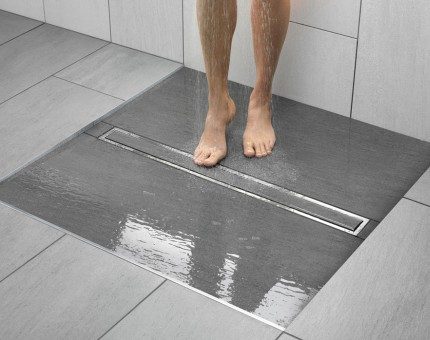
The channel system consists of a drainage channel, a drainage system and a grate.
Components can be made from:
- ceramics;
- durable plastic;
- metal.
Channels are usually sold ready to install. A siphon system is also included in the design. After the purchase, it remains to connect them with a corrugated pipe to the sewer and lay the tiles on top.
The sizes of standard channels range from 50 cm to 118.5 cm. Elements of the system are interchangeable, so it is possible to choose each part individually to your liking.
Precision shower drain
The design of the shower drain is a floor mounted device for receiving wastewater. Sometimes drainage is considered a kind of gangway, because the mass of engineering drainage systems really erases the line between the two devices.
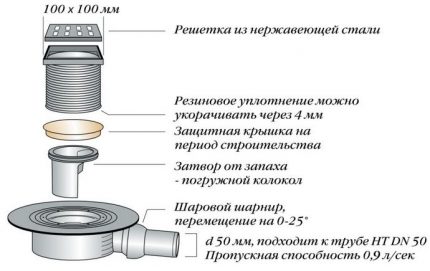
The gangway consists of:
- facial lattice;
- trash bin;
- clamping gaskets and seals for sealing;
- ladder hulls;
- water lock (plum cup).
Ladders can be cast iron, plastic and stainless steel. By design, they are divided into vertical and horizontal.
Vertical gangways can pass large volumes of water, therefore, they are installed mainly in pools, where free access to the drainage system from below is provided.
Horizontal ladders have a lateral drain pipe and are used in most apartments as compact and easy-to-install devices.
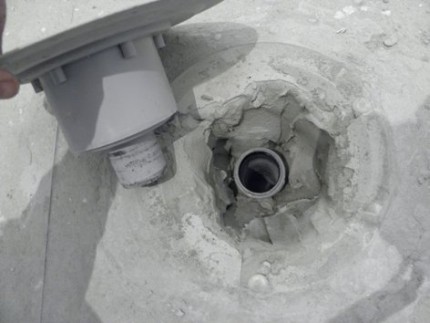
Lattice drain holes can be made square, round, rectangular. The height of the ladder bodies varies from 7.5 to 19 cm.
In choosing such a drain device there are a number of nuances.
- The outer plastic grilles should be thick and durable, given the weight of people who will regularly wash in the shower.
- The advantage when buying give ladders with adjustable height of the hull.
- The drainage capacity must be greater than the incoming water flow.
- The recommended size of the outlet pipe is 50 mm.
- Obligatory presence of a siphon and a trap of foreign particles.
It is better not to save on the quality of the drain ladder poured into the floor, because the seals on cheap models wear out quickly, and the roughness of the internal plastic parts leads to rapid clogging of the siphon.
Standard shower building process pallet with ladder and drain consists of several stages:
Shower traps with drip tray
Cabin manufacturers often use exclusive engineering solutions on pallets that are difficult to attribute to any common siphon categories.
Most models can be divided according to two principles:
- by the mechanism of action;
- by type of construction.
The features of their device should be examined in more detail.
Classification of siphons by the mechanism of action
Differences in the principles of the mechanism of work share existing siphons into 3 main groups.
First group - simple siphons. They are included in the package of most cheap showers in the domestic market. The principle of operation of these siphons is simple: the drain hole is clogged with a plug on top, after which water begins to collect in the pan. When removing the cork, the water goes into the drain.
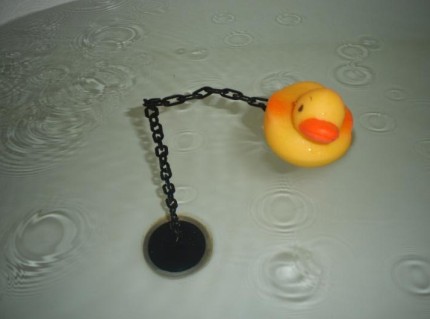
The elementary design ensures low cost of these devices. The danger is their operation, because when you open / close the holes, you can slip and cause injury.
Second group - siphons with manual control. In this design, the control knob is displayed on the wall, when rotated, the drain hole is regulated.
This mechanism of action is especially convenient for people with disabilities who find it difficult to bend to manually close the hole with a stopper.
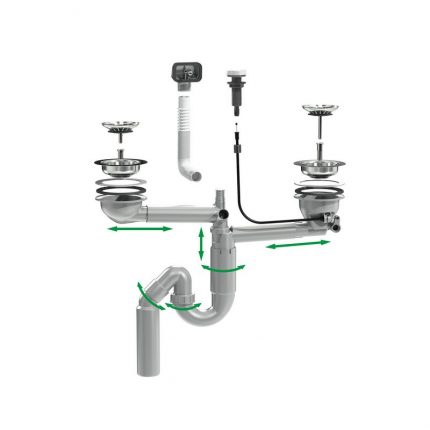
Third group - click-clack system. In such siphons, the plug is stationary above the drain hole and at the same time is an open / closed switch.
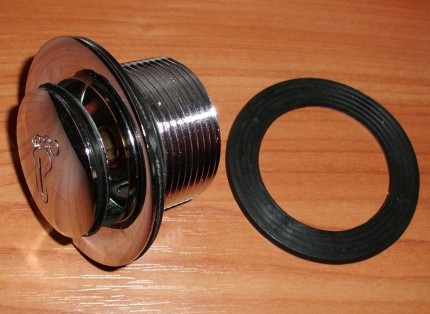
When you first press the cork with your foot, it rises slightly, and the drain hole opens, and when you press it again, the cork is fixed in the closed position and does not allow water to drain.
Structural classification of siphons
Depending on the engineering features of the hydraulic lock mechanism, the siphons are divided into 3 types.
First view - bottle siphons. In apartments, they are universally installed on sinks in the kitchen. This type of siphons got its name because of its oblong appearance. Sedimentation occurs at the bottom of the bottle, which is easy to unscrew and clean from dirt.
A water lock is provided by an internal arrangement of the siphon, which also prevents large objects from entering the side corrugated drainage system.
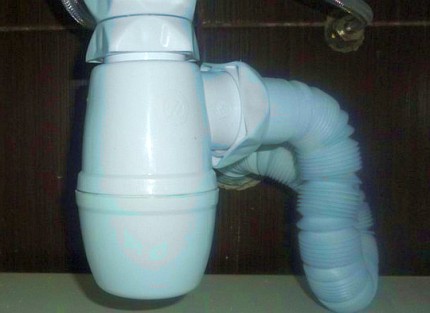
The disadvantage of this siphon is its bulkiness and length, therefore, to install it on a shower cabin, a large gap between the floor and the tray is required.
Second view - classic pipe siphons. Among the systems for draining water from showers, siphons in the form of letters U and S are most common. The formation of a hydraulic shutter occurs directly in the pipe bend.
Such siphons are characterized by reliability and durability, and their compact modifications are used in most budget showers.

The disadvantage of this type of siphon is the inconvenience of dismantling and cleaning, especially in conditions of limited space under the shower tray.
Third view - corrugated siphons. This type of siphon drain is an empty tube in the form of a corner, one end of which is attached to the hole of the pallet, and the second goes into the corrugated hose.
The siphon can be installed at any angle to the horizontal plane, which makes it convenient for non-standard options for placing the drain. This model is often used in showers with low pallet.
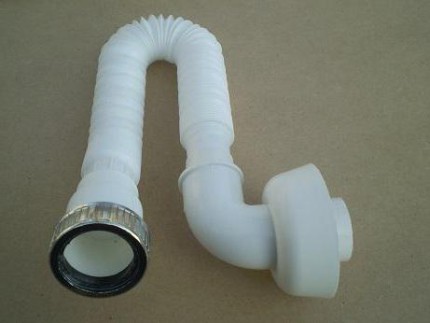
A water trap in corrugated siphons is formed manually at a place remote from the drain. To do this, the hose bends in the form of the letter U and is fixed in this position below the level of the opening of the pallet.
There are also exclusive siphon variants combining the features of several constructional variants at once.
Arrangement of a drain for a shower cabin
When installing a shower booth, special attention should be paid to the construction of a drain. After all, how well it will be done depends on the service life of the cabin and its comfortable operation. So, an improperly connected drain can quickly leak or cause unpleasant odors in the bathroom.
Let's take a closer look at the stages of arranging a bathroom drain.
Stage # 1. Shower channel installation
Installation of the channel drain in the bathroom takes place directly on the floor, with fixation from all sides with cement mortar. Before installing the channel, it is necessary to glue the grate with adhesive tape to protect the polished surface from damage.
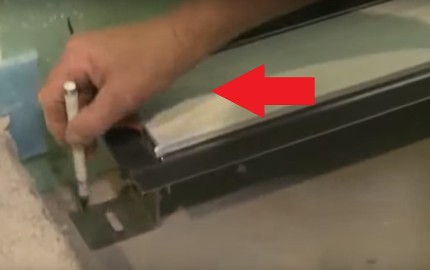
If the outer surface of the channel is polished, it is necessary to roughen it with an emery cloth so that the cement slurry adheres better. After processing, it is necessary to treat the surface with a degreasing solution.
Next, you need to fix the channel with brackets to the floor and ground the drain pan body, if it is made of metal.
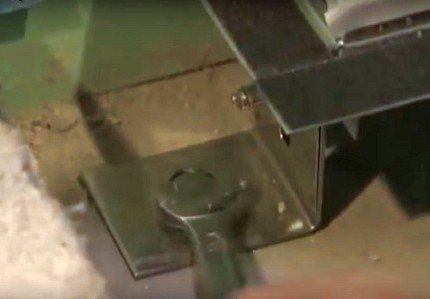
Align the tray horizontally using the side adjusters.
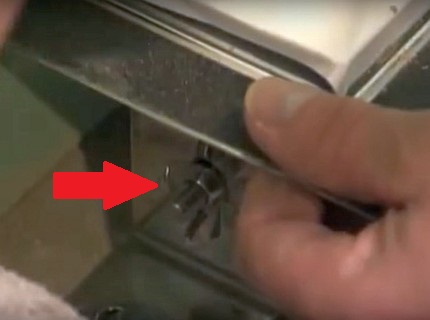
Attach one edge of the connecting hose to the channel nozzle, and the second to the sewer pipe. Make sure that the hose is fully inserted and snaps into place.
If water leakage is suspected, the pipe must be pretreated with a thin layer of silicone.
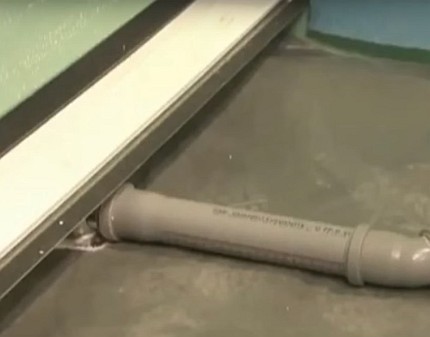
The next step is to fill the space on the sides of the channel with cement, taking into account the thickness of the tiles, which will lie on top.
Then put a tile on the cement, the top of which should be 1 mm above the level of the channel so that water does not accumulate at the grate. The tiles in the bathroom must be laid from the drain tray to guarantee an even joint and no sharp edges on all sides.
To drain the water, there should be a slope of the tile from the sides of the shower area to the drain at the rate of 1-1.5 cm of height per 1 m of floor length.
After laying the tiles, it is necessary to clean the place of its junction with the edge of the channel grate and fill with tile glue or sealant. After it dries, it is necessary to finally clean the space along the edges of the channel drain and remove the protective film from the grate. The drain is ready!
When installing a channel drain, the following nuances must be taken into account:
- The channel capacity should not be less than the flow rate of water in the shower. The classic hot tub uses 10 liters of views per minute.
- The distance from the outlet of the drainage tray to the vertical sewer pipe should be minimal.
- If in doubt about the throughput of the drainage system, you can check it. To do this, you need to fix the tray to the floor, attach it to the sewer pipe and apply water pressure to the tray.
- The diameter of the hose going from the nozzle should not be less than 40 mm, and its slope should be less than 30 mm per 1 m.
- When installing a channel drain in the bathroom door, it is recommended to select a sectional grill to facilitate access to the siphon.
Following the instructions will allow you to install the channel drain in the shower quickly and efficiently. You should not be afraid of clogging in the built-in drainage tray, because its design provides for cleaning the system from the outside without the need to dismantle the tiles.
Stage # 2. Installation of a drainage ladder
Installation of a shower ladder is carried out similarly to the channel drain installation scheme described above. Cheap drainage gangways are sold without fixing devices, so when installing them you should know one caveat.
If the external drainage device has the form of a simple body with an internal mechanism and a discharge hose, then you must first firmly fix it in the desired position.
To fix the height, you can put a brick, several tiles or other improvised material under the body.
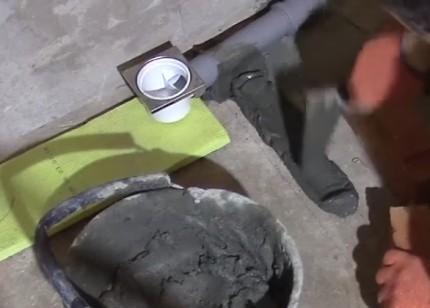
With the regulation of horizontal stability, the situation is more complicated. In the absence of fasteners, it will be necessary to control the correct location of the ladder body after laying the cement screed during its drying.
The general scheme of the layers of the shower floor with installation of a ladder as follows.
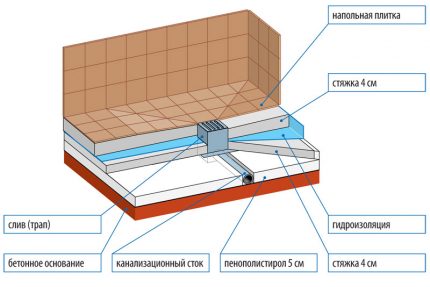
The diagram shows a square spillway with fixing elements. The blockages in the drain are cleaned after removing the grate and removing the internal elements.
The ladder body is actually a hollow flask with a nozzle, so after disassembling it, you can even clean the drain hose with a cable.
Stage # 3. Installing a shower trap on a pallet
The process of installing a siphon is so diverse that step-by-step tips on installing a specific shower drain can be found only in its installation instructions.
Below we will consider the installation of one of the simple types of siphon to understand the fundamental stages of this process. The general scheme of the device is shown in the figure.
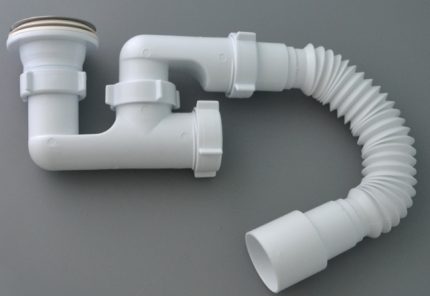
The first thing to do is to attach a drain pipe to the neck seal. You need to take the drain pipe and put on a conical gum.
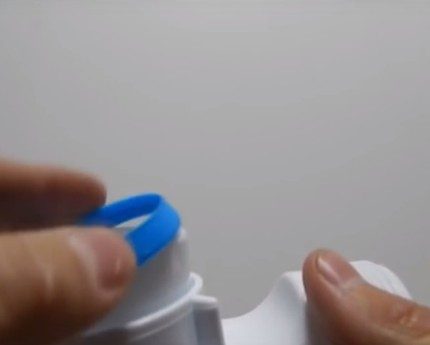
Turn the pipe over, insert it from above into the water seal and fix it with a nut.
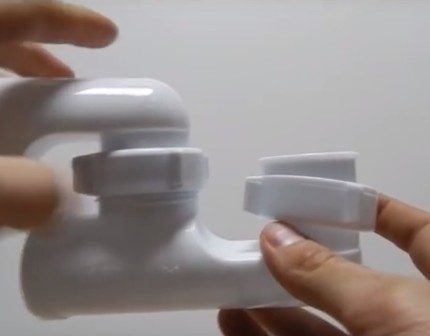
Put the rubber gasket in the plug and screw it to the side outlet of the hydraulic lock. Not all siphons are equipped with such a plug, but this design is a priority when choosing a drain mechanism.
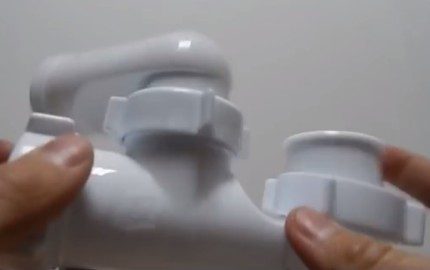
Put a rubber gasket on the second outlet of the hydraulic lock, place a neck on it and tighten the fixing nut.
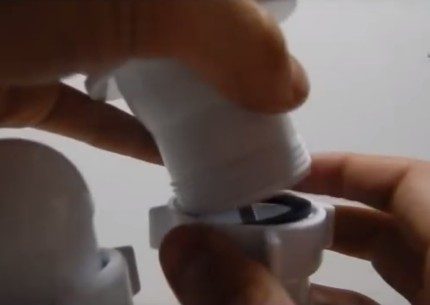
It turns out the finished siphon, which must be attached on one side to the pallet, and the second to the corrugated drain hose.
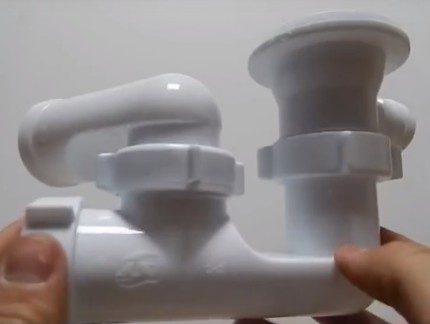
Next, prepare the neck for mounting on a pallet. To seal the connection, it is necessary to put a special wide rubber gasket on the upper part of the neck. On the inside of the pallet is also a rubber band.
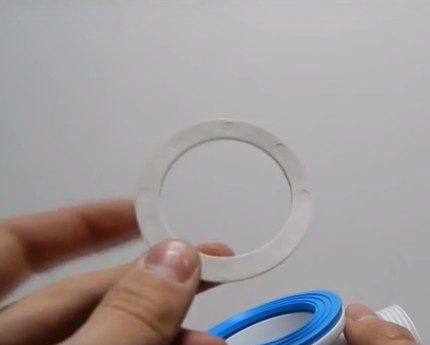
Then the neck is placed on the bottom of the pan, and the top of the siphon with a drain hole and a fixing bolt is on top. The bolt is screwed with a screwdriver, and on this the siphon mount to the shower stall ends.
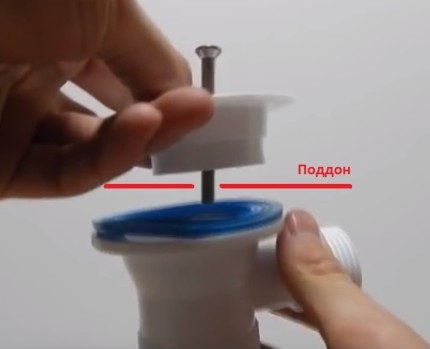
The next step is to attach the corrugated hose to the outlet of the siphon and the overflow hole (if any). It turns out a ready-to-use siphon.
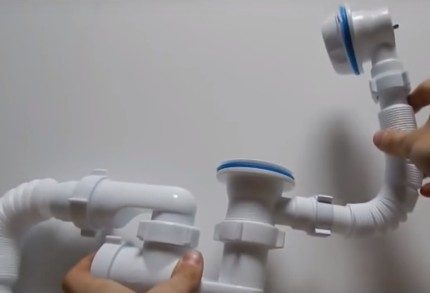
All of the above procedures are preferably carried out on an inverted tray before installing the shower on the floor. And then the connected siphon will only need to be connected to the sewer pipe.
Secrets of choosing and installing siphons
Before buying and installing a new shower, it is advisable to familiarize yourself with the advice of experts so that you do not have to exchange goods, change your own design or buy suitable parts.
Some important recommendations:
- Before buying a siphon, you need to measure the distance between the outlet of the pan and the floor so that the siphon body fits under the shower. Most often there are drainage mechanisms measuring 80-200 mm.
- The size of the drain hole of the pan should correspond to the width of the neck of the siphon. Their standard sizes are 52, 62 and 90 mm.
- The lower level of the outgoing siphon pipe should be higher than the level of the sewer opening.
- To maintain water flow in low-level pallets with compact drainage systems, priority should be given to filtering debris at the inlet of the drain hole.
It is necessary to take into account the advice of sellers, who understand the nuances of installing specific booth models and siphons presented in their plumbing store.
Conclusions and useful video on the topic
The videos will introduce you to the nuances of installing plumbing fixtures that will help you complete the installation and cab connection without the help of specialists.
The device, the scheme of operation and installation of the drain ladder:
The device and repair of a siphon for a shower tray:
Having considered the nuances of choosing siphons and their installation, you can safely go to the store to buy a shower. Now it’s clear what equipment is suitable for your bathroom and how to operate it for a long time and without breakdowns.
Do you have practical skills in installing showers and connecting a drain? Share your knowledge or ask questions about the arrangement of the drain system of the shower in the comments below.

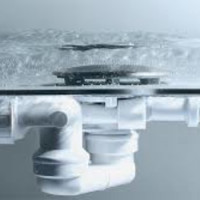 Siphon for a shower cabin with a low pallet: types, selection rules, assembly and installation
Siphon for a shower cabin with a low pallet: types, selection rules, assembly and installation 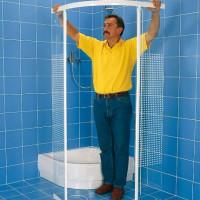 Repair of a shower cabin: how to repair popular damage to a shower cabin with your own hands
Repair of a shower cabin: how to repair popular damage to a shower cabin with your own hands 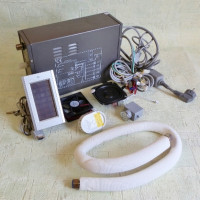 Steam generator for a shower cabin: types, principle of operation + recommendations for selection and installation
Steam generator for a shower cabin: types, principle of operation + recommendations for selection and installation 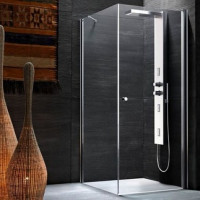 The device of a shower cabin without a pallet: detailed assembly instructions
The device of a shower cabin without a pallet: detailed assembly instructions 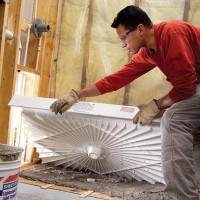 How to assemble a shower tray: mounting options for typical options
How to assemble a shower tray: mounting options for typical options 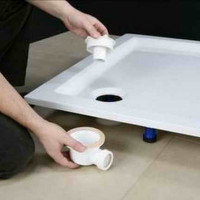 Siphon for shower tray: design, purpose, installation features
Siphon for shower tray: design, purpose, installation features  How much does it cost to connect gas to a private house: the price of organizing gas supply
How much does it cost to connect gas to a private house: the price of organizing gas supply  The best washing machines with dryer: model rating and customer tips
The best washing machines with dryer: model rating and customer tips  What is the color temperature of light and the nuances of choosing the temperature of the lamps to suit your needs
What is the color temperature of light and the nuances of choosing the temperature of the lamps to suit your needs  Replacement of a geyser in an apartment: replacement paperwork + basic norms and requirements
Replacement of a geyser in an apartment: replacement paperwork + basic norms and requirements
We have a good shower, set recently. But the daughter thrust something from toys there when she bathed. It turned out that water was difficult to pass, and it was not possible to get it.
It was not possible to clean with a metal cable, since he was afraid to break through the drain, the outlet hose was corrugated. I had to unwind everything and watch every node. Work dragged on all day. Now I put a special plug to prevent this from happening again.